Royal Carriages

Beez Neez now Chy Whella
Big Bear and Pepe Millard
Mon 21 Aug 2017 22:27
|
The Carriages Housed at the
Royal Mews
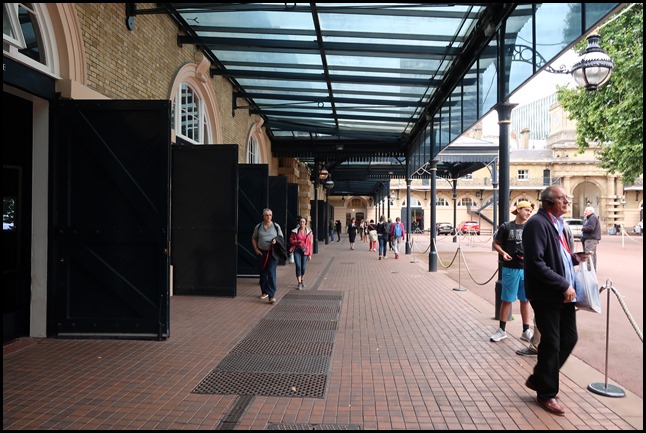 Picture taken standing at the far end
of the first ‘side of the square’. The royal carriages are
all parked in the bays to the left, the second bay holds one of the royal
cars and the bay to my left held display cases of liveries. Colour me happy that
each carriage had an information board on the door with pictures of the carriage
in use. Back to the far end to begin looking............
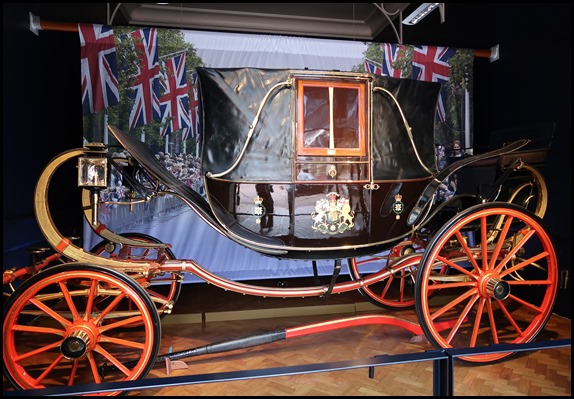 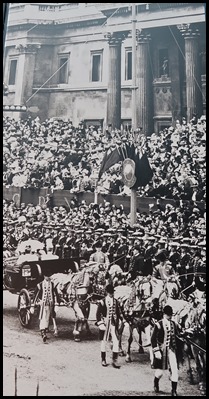 Semi-State
Landau: This Semi-State Landau is one of several similar coaches at the
Royal Mews today. The landau became popular during the nineteenth century as it
could be used in both town and country with the hoods open or
closed.
The landau was particularly
favoured by Queen Victoria, who enjoyed fresh air, and noted in her journal of
travelling in an open landau from London’s Victoria Station to Buckingham Palace
after “it had snowed all night”.
The Semi-State Landaus were
initially plainer town carriages but were gilded and decorated for Queen
Victoria’s Golden Jubilee. They were used again for the 1897 Diamond Jubilee
procession, one of which was used to transport the Queen.
Today, the Semi-State Landaus are
in regular use for official and ceremonial duties. Newly-appointed High
Commissioners travel in them on the day they present their credentials to The
Queen.
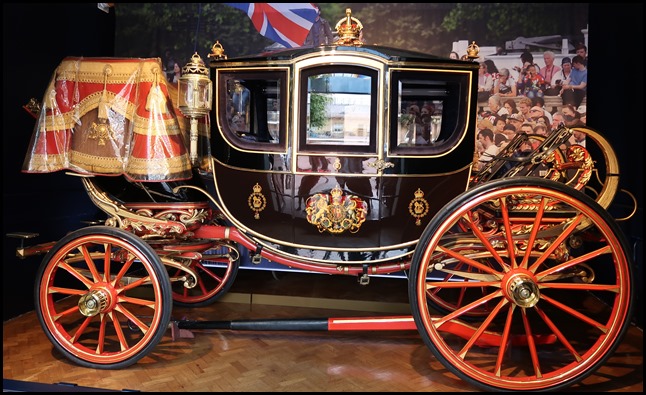   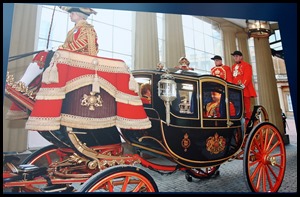 Queen
Alexandra’s State Coach: Built in 1865, this coach was converted into a
glass coach in 1893 for the Princess of Wales, later Queen Alexandra, consort of
King Edward VII. She used it for social events until her death in
1925.
Since 1962 this coach has carried
the Imperial State Crown, the Sword of State and Cap of Maintenance in its own
procession, which travels before The Queen’s carriage during the State Opening
of Parliament. When the Crown and regalia is travelling to Parliament, it is
entitled to a Household Cavalry escort and royal salute. The Crown sits in the
coach on a crimson cushion and is lit by electric light.
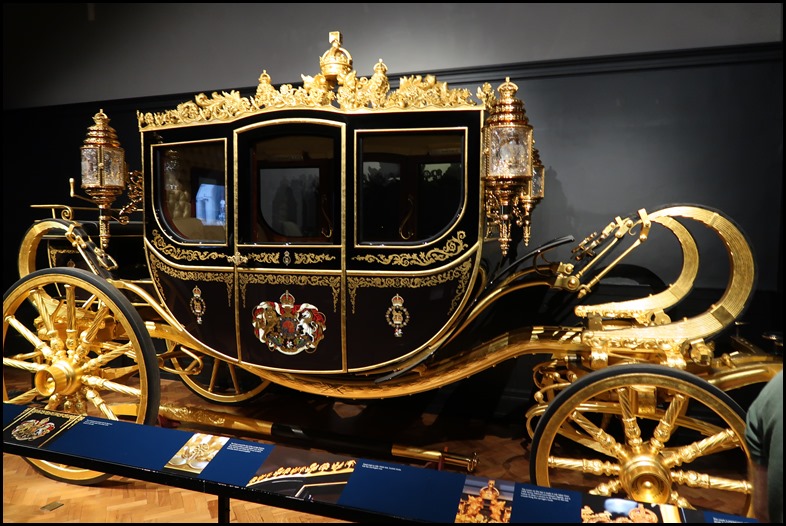 The Diamond
Jubilee State Coach: This coach is the newest coach in the Royal Mews. It
was created for The Queen to commemorate her Diamond Jubilee and was conceived
of and built in Australia by a team led by Mr J. Frecklington, a former employee
at the Mews. The coach is postilion-driven by a groom on each pair of horses,
and is almost five-and-a-half metres long, over three metres high and weighs
over three tonnes. The body is aluminium which gives it strength and stability.
Curving up from the wheels at either side of the footmen’s seat are the
traditional springs made from tubular steel, which form part of the suspension.
Uniquely, this coach has six hydraulic stabilisers to prevent the body from
swaying.
The coach is painted black with heraldic and scrolling details in gold.
The paint was built up over several layers: firstly egg white and water were
applied, the designs were then outlined and painted in ‘size’, followed by a
mixture of gold paint and pigment. Finally gold leaf was added which is
burnished to produce the lustre.
The two door handles, made by a New Zealand jeweller, are individually decorated with 24 diamonds and 130 sapphires.  The crown on the top is made in
oak taken from HMS Victory, Admiral Nelson’s flagship and is hollow to
allow a camera to be fitted to film the crowds lining the
carriage’s route.
  The frieze around the top of the carriage features the national
emblems of the English rose, Scottish thistle, Irish flax and Welsh leek. It was
carved in Australian beech wood and gilded.
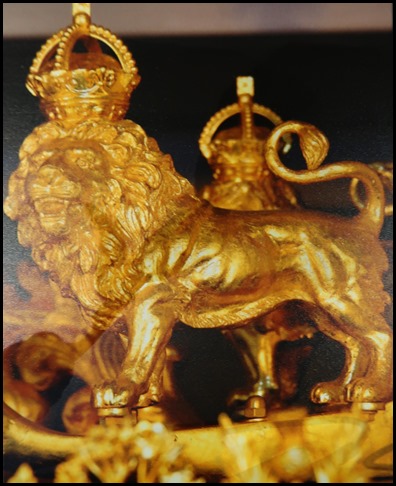 One of the
four crowned lions that decorate the roof of the coach.
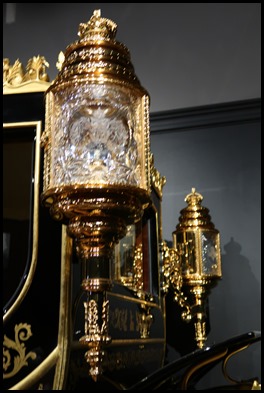 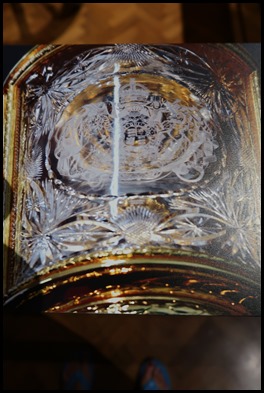 The Crystal lanterns were hand-blow
and cut in Edinburgh.
 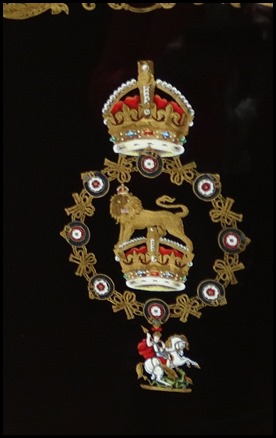 The central
panel is painted with the Royal coat of arms,
with the collar of the Order of the Garter on the
sides.
 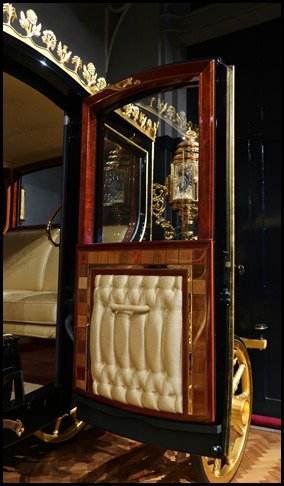 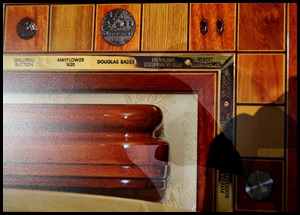 The interior
of the coach is lined in yellow silk and the structure is inlaid with
various historic timbers. The seat handrails are from the Royal Yacht Britannia,
with sections of the window frames sourced from historic structures including
Caernarfon Castle, Canterbury Cathedral, Durham Cathedral, Henry VIII’s
flagship The Mary Rose and fragments from the Antarctic bases of
Captain Scott and Sir Ernest Shackleton. It also includes a fragment of stone of Scone – the sandstone
block which has sat under the Coronation Chair at all coronations since 1308 – a
British lead musket ball from the battlefield at Waterloo, a piece of metal from
the casting of the Victoria Cross (the highest award for military bravery), the
metal comes from Russian guns captured at Sebastopol and finally, an original
counterweight from Big Ben.
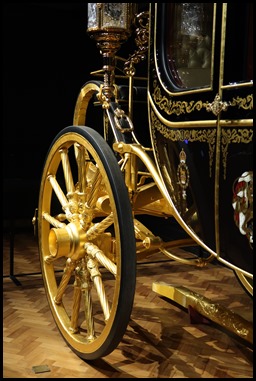  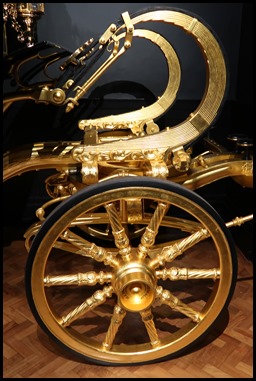 The wheels each bear the name of the coach
maker at the centre.
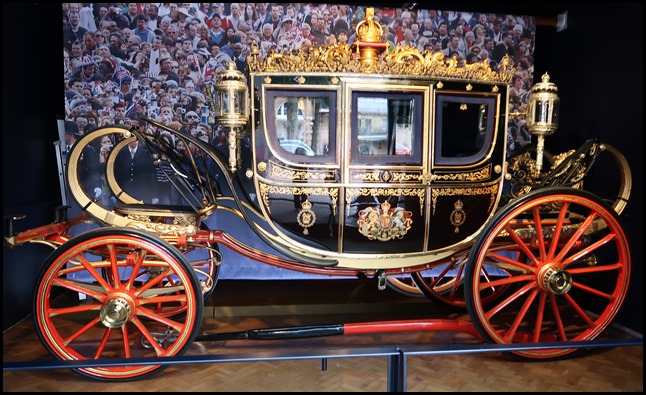 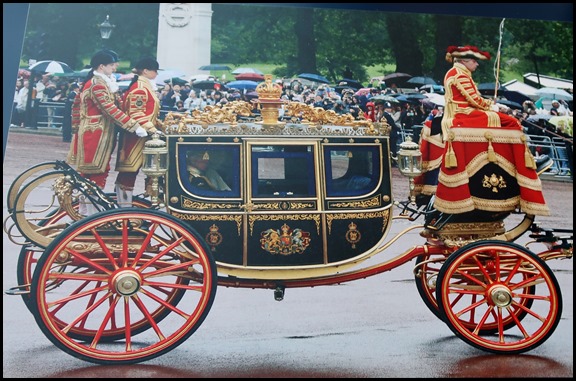 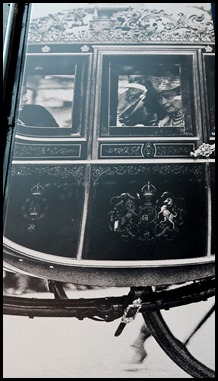 Irish State
Coach: “....a state carriage built for me”. Queen Victoria’s
Journal, 2nd September 1853.
The original Irish State Coach
was exhibited in 1851 by John Hutton & Sons of Dublin, and was exhibited in
the 1853 Great Industrial Exhibition, Dublin, with the hope of attracting the
attention of Queen Victoria and Prince Albert. The coach was purchased by the
royal couple and after the death of her husband it was often used by Queen
Victoria when she no longer wished to use the Gold State Coach. In 1876 when
Victoria was proclaimed Empress of India she had the frieze added to the top of
the coach. It includes the palm of India amongst the rose of England and the
shamrock of Ireland.
In February 1911, whilst
undergoing restoration for the coronation of King George V, the wooden body of
the carriage was destroyed by fire. It was rebuilt on its original chassis in 19
weeks, and took part in the coronation procession.
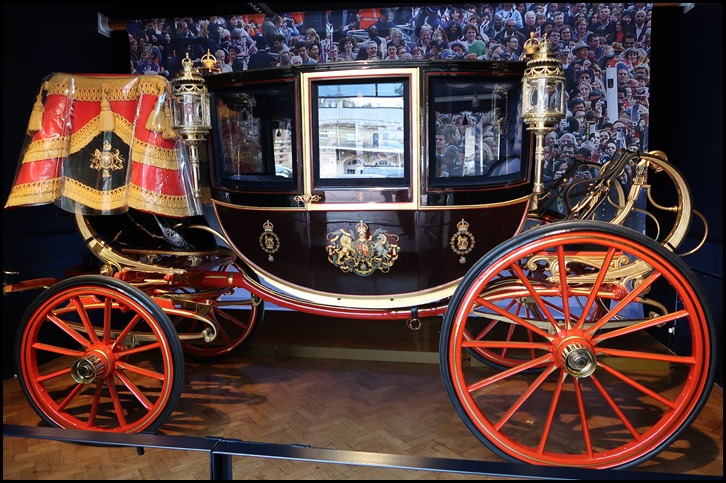 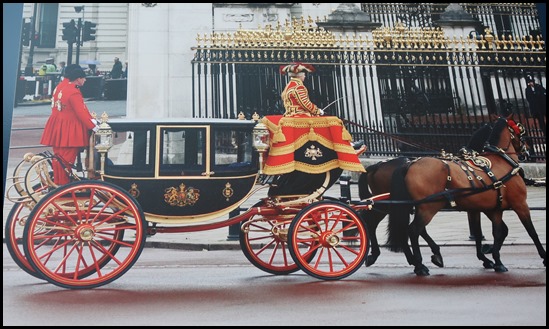 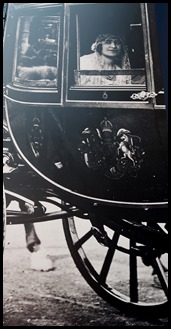 The Glass
Coach: This coach carried Lady Elizabeth Bowes Lyon, later Queen
Elizabeth The Queen Mother, to Westminster Abbey for her wedding to The Duke of
York (later King George VI) on the 26th of April 1923. Twenty years later, this
same coach carried their daughter, the future Queen Elizabeth II, to her
wedding. It was originally acquired for the 1911 coronation of King George V.
Its name comes from the use of glass in all the top panels except for the back.
The coach has been used for several royal weddings, usually to convey the bride
to the ceremony.
The interior is lined with blue
satin and the exterior panels are painted with the royal arms in the centre,
flanked by the heraldry of the Order of the Garter. The coach weighs one tonne.
It is usually the second carriage in the procession behind The Queen’s carriage
for the State Opening of Parliament, and carries the ladies-in-waiting and the
Master of the Horse.
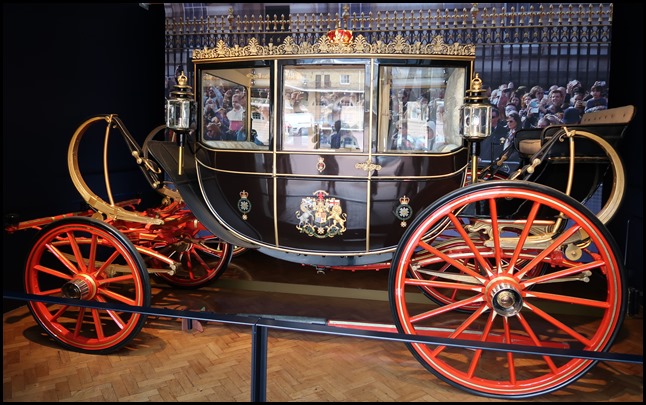 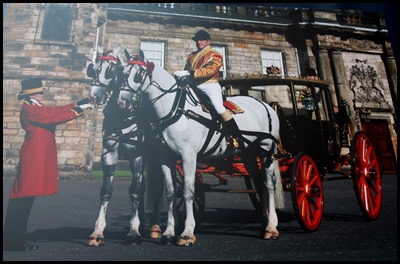 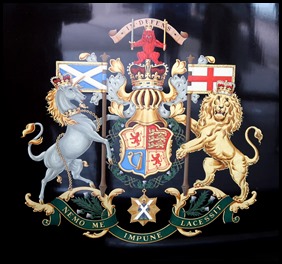 Scottish
State Coach: The Scottish State Coach was originally built c.1830 and was
acquired by Queen Mary in 1930.
In 1968 the coach was converted
into the Scottish State Coach. The royal arms of Scotland and the Order of the
Thistle insignia were added to the coach panels. The roof had two transparent
panels inserted, which makes the interior much lighter. On the top is a
fibreglass model of the Crown of Scotland.
The Queen travelled in the coach
to the General Assembly of the Church of Scotland in 1969 and 2002. The coach is
also used n London during state processions. In 2016 the coach featured in The
Queen’s 90th birthday celebrations at Windsor Castle and at the Royal Edinburgh
Military Tattoo.
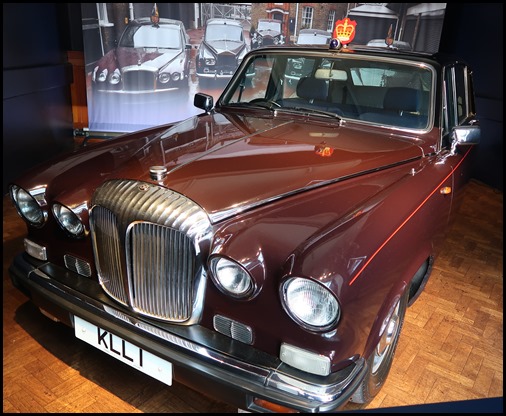 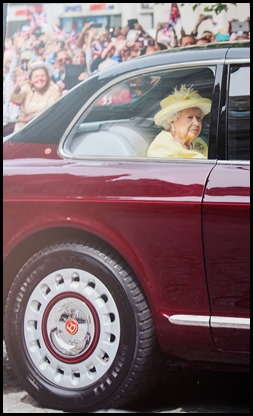 Royal Cars: The Royal Mews is
also home to the official motor cars used by the Royal Family.
All state cars are painted maroon
and black and today include three Rolls-Royces, three Daimlers and two Bentley.
Two green jaguar stretched limousines are also garaged at the Royal Mews for use
at less formal events. The oldest car in the Mews is the 1950 Rolls-Royce Phantom IV, ordered by Princess Elizabeth
and the Duke of Edinburgh soon after their wedding. The most recent cars are the
two maroon Bentleys, one of which was presented to The Queen as a Golden Jubilee
gift in 2002. They were designed with input from The Queen, The Duke of
Edinburgh and the Head Chauffeur.
Every cay is washed in cold water
and valeted after each use. Many of the cars feature modifications necessary to
their unique use, such as engines which can run at three miles per hour for long
distances during processions and Perspex roof fittings to enable crowds to see
the occupants. The modern biofuel-powered Bentleys, have ‘coach-doors’ where the
rear doors are hinged at the back to ninety degrees. This allows a more
dignified exit from the vehicle with the occupants able to stand up straight
before exiting.
The Queen’s car flies the Royal
Standard from the roof attachment whenever Her Majesty is travelling in the
vehicle;there is also a special mascot, a silver figure of St George killing the
dragon, which can be attached to the bonnet. The cars Her Majesty and The Duke
of Edinburgh use carry no number plates.
ALL IN ALL SUPERB TO
SEE
AWESOME |